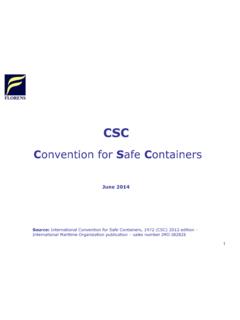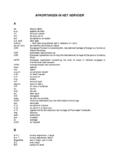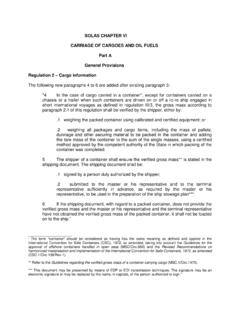Transcription of GUIDE TO CONVENTION FOR SAFE CONTAINERS …
1 GUIDE TO CONVENTION FOR safe CONTAINERS (CSC). reinspection OF MODULAR CAUSEWAY SYSTEMS (MCS) ISOPAK. COMPONENTS. Prepared by: Randy Cassner (586) 574-6998. Product Quality Manager RDECOM. Form Approved Report Documentation Page OMB No. 0704-0188. Public reporting burden for the collection of information is estimated to average 1 hour per response, including the time for reviewing instructions, searching existing data sources, gathering and maintaining the data needed, and completing and reviewing the collection of information. Send comments regarding this burden estimate or any other aspect of this collection of information, including suggestions for reducing this burden, to Washington Headquarters Services, Directorate for Information Operations and Reports, 1215 Jefferson Davis Highway, Suite 1204, Arlington VA 22202-4302. Respondents should be aware that notwithstanding any other provision of law, no person shall be subject to a penalty for failing to comply with a collection of information if it does not display a currently valid OMB control number.
2 1. REPORT DATE 2. REPORT TYPE 3. DATES COVERED. 10 JUN 2006 N/A - 4. TITLE AND SUBTITLE 5a. CONTRACT NUMBER. GUIDE to CONVENTION for safe CONTAINERS (CSC) reinspection of Modular 5b. GRANT NUMBER. Causeway Systems (MCS) Isopak Components 5c. PROGRAM ELEMENT NUMBER. 6. AUTHOR(S) 5d. PROJECT NUMBER. Cassner, Randy 5e. TASK NUMBER. 5f. WORK UNIT NUMBER. 7. PERFORMING ORGANIZATION NAME(S) AND ADDRESS(ES) 8. PERFORMING ORGANIZATION. REPORT NUMBER. USA TACOM 6501 E 11 MILE ROAD WARREN, MI 48397-5000. 15898. 9. SPONSORING/MONITORING AGENCY NAME(S) AND ADDRESS(ES) 10. SPONSOR/MONITOR'S ACRONYM(S). TACOM TARDEC. 11. SPONSOR/MONITOR'S REPORT. NUMBER(S). 12. DISTRIBUTION/AVAILABILITY STATEMENT. Approved for public release, distribution unlimited 13. SUPPLEMENTARY NOTES. The original document contains color images. 14. ABSTRACT. 15. SUBJECT TERMS. 16. SECURITY CLASSIFICATION OF: 17. LIMITATION OF 18. NUMBER 19a.
3 NAME OF. ABSTRACT OF PAGES RESPONSIBLE PERSON. a. REPORT b. ABSTRACT c. THIS PAGE. SAR 15. unclassified unclassified unclassified Standard Form 298 (Rev. 8-98). Prescribed by ANSI Std Z39-18. Army Modular Causeway Systems ISOPAK Components CSC. reinspection Process FOREWORD. In accordance with AR 56-4 paragraph , intermodal configured modular systems must meet regulatory requirements to include CSC certification. In conformance with 49 CFR. 452, in order to maintain CSC certification and ensure continued safe handling and transportability in the commercial intermodal transport environment, the intermodal configured modules must be periodically examined. In accordance with DOD DEFENSE TRANSPORTATION REGULATION PART VI, All ISO CONTAINERS (ISOPAK's are classified as ISO CONTAINERS for purposes of intermodal movement) that move in the Defense Transportation System (DTS) must be certified to meet 49 CFR and CSC/46 app.
4 1503 standards. This Modular Causeway Systems (MCS). reinspection program endeavors to comply with these directives and ensure that no injury to personnel or damage to property occurs from structural failure or deficiency. This document provides reinspection criteria and procedures to be used when visually examining MCS ISOPAK components. The criteria and procedures contained herein enable personnel to identify MCS components that are serviceable and safe for intermodal loading and shipping. This document applies to any commercially owned or military owned Modular Causeway Component System meeting the standards of the International Organization for Standardization (ISO) and certified under the provisions of the International CONVENTION for safe CONTAINERS (CSC). This document is specifically used worldwide by civilians and military personnel responsible for inspecting and selecting serviceable MCS. Components for shipment of Department of Defense (DOD) materiel.
5 This document provides a variety of helpful illustrations. Beneficial comments (recommendations, additions, deletions), and any other pertinent data that may be of use in improving this document, should be addressed to: Commander, Tank Automotive Armaments Command; ATTN: Program Executive Office Combat Support and Combat Service Support (PEO CS& CSS), Warren Michigan 48397-5000; or by letter. 1. GENERAL. Purpose This document provides inspection criteria and procedures will be used when visually examining MCS Components. Following the criteria and procedures contained herein will enable personnel to identify MCS Components that are serviceable and safe for loading and shipping. MCS is constructed of many different components, the inspection of each component is to recertify that they may be used in an ISOPAK or identify the component as unserviceable. NOTE: This document is not to be used as the standard for performing container repairs.
6 Scope This document applies to the selection of any commercially owned or military owned MCS components meeting the standards of the International Organization for Standardization (ISO), and certified under the provisions of the International CONVENTION for safe CONTAINERS (CSC). This document is specifically used worldwide by civilians and military personnel responsible for inspecting and selecting serviceable MCS. components for shipment of Department of Defense (DOD) materiel. Objective Inspecting personnel will use this document to cause: a. Inspection standardization among DOD agencies for acceptability of MCS modules owned by the DOD. b. Preparation of inspection reports that are properly annotated to reflect MCS component condition and reason(s) for rejection; and c. Compliance with international treaties, conventions, and United States transportation law. 2. container INSPECTION CRITERIA. General Requirements Regulatory Mandates: An MCS ISOPAK may not be offered for the carriage of any type unless the container is structurally serviceable as evidenced by a valid CSC.
7 Safety Approval Plate and verified by a detailed visual examination. The CSC Safety Approval Plate and the visual examination must conform to the mandates of 49 CFR, parts 451 and 452. Furthermore, if the MCS has any Hazardous Material, it must meet specific structural serviceability requirements as prescribed by the IMDG Code and mandated by 49 CFR Part If an MCS has any safety related deficiency or damage that could place any person in danger, it will not be used. Markings and Data Plates: Each MCS module must bear a legible and valid CSC. Safety Approval Plate marked in accordance with CSC format requirements. The CSC. Safety Approval Plate will be securely affixed at a readily visible place on the MCS, where it is not easily damaged. All maximum gross weight markings on the manufacturer's data plate must be consistent with the maximum gross weight marking on the CSC Safety Approval Plate. No ISO PAK is constrained by specific serial numbers.
8 Each component/module is a stand-alone unit that may be configured into an ISO PAK. An ISO PAK is defined as a group of components, when assembled, meets the ISO. dimensional requirements for an intermodal container . Configuration: Any distortion of the overall configuration great enough to preclude proper engagement of handling/lifting equipment, mounting and securing on chassis, vehicle, or aircraft pallet, or insertion into the cell of a ship is unacceptable. Side-to-side connector castings may not protrude beyond the ISO envelope by not more than 3/8. The external dimensions must conform to the tolerances prescribed by ISO standard 668 as depicted in Figure 2 .1. External Dimensions and Tolerances in Millimeters and Feet and Inches Nominal L (External Length) S K 1 MAX. Length FT MM FT IN MM FT IN MM IN. 40 12,192 +0 40 0 +0 11,985 + 6 39 3-7/8 + 19 3/4. - 10 - 3/8 -6 - . 20 6,058 +0 19 10 + 0 5,853 +5 19 2-7/16 + 3/16 13 1/2.
9 -6 - -5 - 3/16. Note: side-to-side connector casting do protrude beyond the ISO envelope by not than 3/8. W (External Width) P K 2 MAX. MM FT IN MM FT IN M IN. M. All 2,438 +0 8 0 +0 2,259 + 4 7 4 31/32 + 5/32 10 3/8. Lengths - 5 - 3/16 - 4 - 5/32. Nominal H (Overall Height) S = LENGTH BETWEEN CENTERS OF CORNER. Length FITTING APERTURES. FT MM FT IN P = WIDTH BETWEEN CENTERS OF. 9 1/2 2,896 + 0 9 6 +0 CORNER FITTING APERTURES. -5 - 3/16. 8 1/2 2,591 +0 8 6 +0 D = DISTANCE BETWEEN CENTERS OF. -5 - 3/16 APERTURES OF DIAGONALLY OPPOSITE. 8 2,438 +0 8 0 +0 CORNER FITTINGS. -5 - 3/16. 5 2/3 1,727 +0 5 8 +0 K1 = DIFFERENCE BETWEEN D1 AND D2 OR. -5 - 3/16 D3 AND D4. 4 1/4 1,295 +0 4 3 +0. -5 - 3/16 K2 = DIFFERENCE BETWEEN D5 AND D6. FIGURE ISO DIMENSIONS AND TOLERANCES. Primary Structural Components: An MCS with any major defect in any component of its primary structure is unacceptable. For purposes of this criterion, primary (main).
10 Structural components (members) include: corner fittings, corner posts, top, bottom, and sides. Acceptable Welding Patterns: MCS are originally deemed suitable for use if they have been given CSC certification by such agencies as the United States Coast Guard (USCG) or USCG appointed agencies. These agencies are highly reputable and bear the liability that the MCS is manufactured in accordance with ISO and CSC requirements. Welding patterns conforming to the original manufacturer's design are, therefore, acceptable. Since welding patterns may vary depending on design and manufacture, inspection should be directed at looking for broken junctures or welded repairs that are not consistent with other corresponding welds of that container . Acceptable Repairs: For purposes of these criteria, a repair is any repair of a primary structural member that replaces material without complete replacement of the member.














